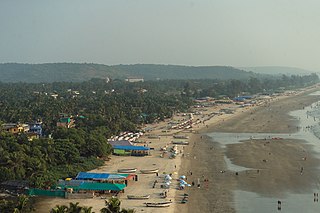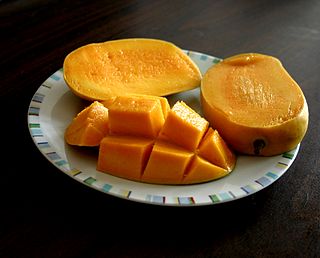Related Research Articles

The Alphonso mango is a named mango cultivar that originated in India.

Arambol is a traditional fisherman village in the Pernem administrative region of North Goa, India, located 24.6 km (15.3 mi) north of Goa's capital city of Panaji. As of 2011, it has a population of around 5,300.

Agaçaim or Agassaim, is a village on the northern banks of the Zuari River in Tiswadi, Goa, surrounded by Panjim to the north, Margão to the south, Vasco da Gama to the west and Ponda to the east, thus making it a main connection between North Goa and South Goa via the Zuari Bridge. Agaçaim is famous for its Goan chouriço.

Banganapalle mangoes is a mango variety produced in Banganapalle of Nandyal District in the Indian state of Andhra Pradesh. It alone occupies 70% percent of total mango cultivable area of the state and was first introduced by the farmers of Banaganapalli. It was registered as one of the geographical indication from Andhra Pradesh on 3 May 2017, under horticultural products by Geographical Indication Registry. It is also grown in the other parts of India and Pakistan. The fruit is described as obliquely oval in shape, around 20cm in length, with yellow flesh and a thin, smooth yellow skin. The flesh is of a firm, meaty texture and is sweet and lacks fibre. The cultivar is the most sought after in Andhra Pradesh. It is a very late-season variety that is good for canning. This cultivar is a source of vitamin A & C and is also called king of Mangoes.

The 'Gir Kesar' mango, also called Kesar, is a mango cultivar grown in the foothills of Girnar in Gujarat, western India. The mango is known for its bright orange colored pulp and was given the geographical indication status in 2011. The biggest market of Gir Kesar is in Talala Gir known as a Mango Market Yard.
The 'Kari Ishad' mango, is a mango cultivar primarily grown in Ankola and Karwar talukas of Uttara Kannada district, Karnataka, India.

The Khola chilli is a variety of chilli mainly grown in the Indian state of Goa.

The Harmal chilli is a variety of chilli mainly grown in the Indian state of Goa.
The 'Appemidi' mango, is a mango cultivar primarily grown in Malenadu region of Karnataka, India. Appe midi is the variation of the same name. Appemidi varieties include Ananta Bhattana, Kanchappa, and Karnakundala.
The 'Kuttiattoor' mango or Kuttiattoor Manga, is a mango cultivar primarily grown in the village of Kuttiattoor, Kannur district of Kerala, India. 'Nambiar maanga', 'Kannapuram maanga', 'Kunjimangalam manga' and 'Vadakkumbhagam manga,' are the variations of the same name.
The 'Malihabadi Dusseheri' mango, is a mango cultivar primarily grown in the town of Malihabad, Lucknow district of Uttar Pradesh, India. The Malihabadi Dusseheri mangoes are unique from the Dussehri variety grown elsewhere in India.
The 'Marathwada Kesar mango', is a mango cultivar primarily grown in Marathwada region of Maharashtra, India. Districts where they are primarily grown are Chhatrapati Sambhaji Nagar, Jalna, Beed and Latur.
The 'Rewa Sunderja' mango, is a mango cultivar primarily grown in Govindgarh of Rewa district, Madhya Pradesh, India.
The 'Rataul' mango, is a mango cultivar primarily grown in Rataul of Baghpat district, Uttar Pradesh, India.
The 'Malda Fazli' mango, is a mango cultivar primarily grown in Malda district, West Bengal, India. It is also known as 'Fazli Babu'.

The Edayur chilli is a variety of chilli mainly grown in the Indian state of Kerala. The Edayur chilli is a local cultivar primarily grown in specific regions of Kerala's Malappuram district. Specifically, it is cultivated in the panchayaths of Edayur, Athavanad, Marakkara, Irimbiliyam, Kalpakanchery, and Valanchery within the Valanchery block, as well as Moorkanad and Kuruva panchayaths within the Angadippuram block.
The Goan cashew refers to the variety of the Cashew fruit grown in the Indian state of Goa, which is one of the major Cashew-growing Indian states. In the entire state of Goa, the cashew crop spans approximately 55,302 hectares, yielding an estimated 27,070 tonnes annually. Goa Kaju or Goa Caju are variations of the same name.

Mushqbudji rice is a variety of non-Basmati, short-grained aromatic rice mainly grown in the Indian Union territory of Jammu and Kashmir growing on the higher reaches of the valley. It is a common and widely cultivated crop in Sagam belt of Anantnag district and the Beerwah belt of Budgam district, and also cultivated in Anantnag and Kulgam in Kashmir by farmers under irrigated conditions.
Adamchini Chawal is a variety of non-Basmati, traditional, short-grained aromatic rice mainly grown in the Indian state of Uttar Pradesh. It is a common and widely cultivated crop in Chandauli, Mirzapur, Varanasi and Sonebhadra, and Vindhya region of Eastern Uttar Pradesh.

Agassaim Brinjal is a variety of brinjal grown in the Indian state of Goa. It is a common and widely cultivated tropical vegetable crop in the village of Agassaim (Aagshi) located in Tiswadi taluka along with similar coastal parts of Tiswadi of North Goa district. It is also cultivated in the coastal parts of Mormugao and Salcete talukas South Goa district.
References
- ↑ Menezes, Vivek (25 May 2017). "Goan mangoes are the best in the world – history proves so, too". Scroll.in. Retrieved 22 September 2024.
- ↑ "Mankurado vs Alphonso| Which Mango Tastes Better, Have Your Say". www.india.com. Retrieved 22 September 2024.
- ↑ Research, Indian Council of Agricultural (1967). The Mango: A Handbook. Indian Council of Agricultural Research. Retrieved 6 November 2024.
- ↑ Team, Herald (2 August 2023). "GOA'S MANKURAD MANGO GETS GI TAG". Herald Goa. Retrieved 22 September 2024.
- ↑ "The roots of Goan mangoes". The Goan EveryDay. Retrieved 22 September 2024.
- ↑ Braganza, Miguel (11 April 2022). "Apart from the famous 'Mankurad', do you know the other mango varieties of Goa?". Goa News on Gomantak Times. Retrieved 22 September 2024.
- ↑ "Goa's Cardozo Mancurad to grow across country". The Times of India. 29 August 2011. Retrieved 22 September 2024.
- ↑ "CARDOZO MANKURAD - A BREAKTHROUGH IN MANGO (MANGIFERA INDICA L.) SELECTION | International Society for Horticultural Science". www.actahort.org. Retrieved 22 September 2024.
- ↑ Litz, Richard E. (1 January 2009). The Mango: Botany, Production and Uses. CABI. ISBN 978-1-84593-490-3 . Retrieved 6 November 2024.
- ↑ Kole, Chittaranjan (6 March 2007). Fruits and Nuts. Springer Science & Business Media. ISBN 978-3-540-34533-6 . Retrieved 6 November 2024.
- ↑ Kandavel, Sangeetha (1 August 2023). "GI tags for Goan mangoes and bebinca, crafts from Rajasthan and U.P." The Hindu. Retrieved 22 September 2024.
- ↑ "Goa's most popular mangoes going for Rs 5,000 a dozen". The Indian Express. 10 February 2024. Retrieved 22 September 2024.
- ↑ "NABARD - National Bank For Agriculture And Rural Development". www.nabard.org. Retrieved 22 September 2024.
- ↑ "Bebinca, mancurad mangoes get GI tag". The Times of India. 3 August 2023. Retrieved 22 September 2024.
- ↑ Times, Navhind (2 August 2023). "Bebinca, Mankurad mango bag GI tag". The Navhind Times. Retrieved 22 September 2024.
- ↑ "Mancurad mango, bebinca among 5 Goan items awaiting GI tag: Goa agriculture minister Ravi Naik". The Times of India. 18 July 2022. Retrieved 22 September 2024.
- ↑ "State starts process to get Geographical Indication tag for three Goan mango types". The Times of India. 28 July 2021. Retrieved 22 September 2024.
- ↑ "Geographical Indications Intellectual Property India". Intellectual Property India. Retrieved 22 September 2024.
